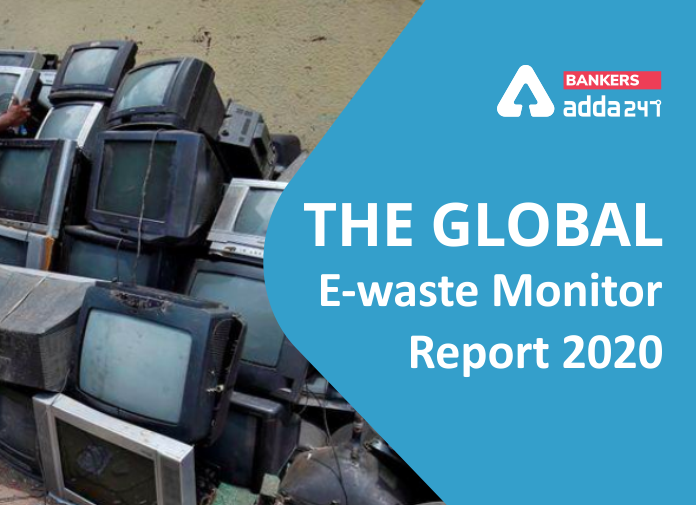The Global E-waste Monitor Report 2020:
The Global E-waste Monitor 2020 is a collaborative product of the Global E-waste Statistics Partnership (GESP), formed by the United Nations University (UNU). According to a recent United Nations University (UNU) report, global e-waste will increase by 38% in the decade between 2020 and 2030.
The Global E-waste Monitor 2020 provides the most comprehensive overview of the global e-waste challenge, explains how it fits into international efforts to reach the Sustainable Development Goals, and discusses how to create a sustainable society and circular economy. The report provides a national and regional analysis on e-waste quantities and legislative instruments, and makes predictions until 2030. It also encourages decision-makers to increase activities to measure and monitor e-waste using an internationally recognized methodological framework.
Also Check
- Global Startup Ecosystems Ranking 2020 released
- THE Young University Ranking 2020 released
- China-Japan: Senkaku Islands Dispute
What is E-Waste?
- E-Waste is short for Electronic-Waste and the term used to describe old, end-of-life or discarded electronic appliances.
- It is categorized into 21 types under two broad categories:
- Information technology and communication equipment.
- Consumer electrical and electronics.
- E-waste includes their components, consumables, parts and spares.
- It consists of toxic elements such as Lead, Mercury, Cadmium, Chromium, Polybrominated biphenyls and Polybrominated diphenyl.
- E-waste consisting of gold, silver, copper, platinum and other high-value, recoverable materials was mostly dumped or burned rather than being collected for treatment and reuse.
Also Check
- Uttarakhand releases report on conservation of endemic, threatened floras
- International Day for the Fight against Illegal, Unreported and Unregulated Fishing: 5 June
Data Analysis of 2019:
- There was 53.6 million tonnes (MT) e-waste in 2019, which is a nearly 21% increase in just five years.
- Asia generated the greatest volume (around 24.9 MT) followed by the Americas (13.1 MT) and Europe (12 MT). Africa and Oceania generated 2.9 MT and 0.7 MT respectively.
- Most E-waste consisted of small and large equipment like screens and monitors, lamps, telecommunication equipment etc and temperature exchange equipment.
- Less than 18% of the e-waste generated in 2019 was collected and recycled.
- E-waste consisting of gold, silver, copper, platinum and other high-value, recoverable materials worth at least USD 57 billion was mostly dumped or burned rather than being collected for treatment and reuse.
- The number of countries that have adopted a national e-waste policy, legislation or regulation has increased from 61 to 78 and includes India.
- It is far from the target set by the International Telecommunication Union to raise the percentage of countries with e-waste legislation to 50%.
Also Check
- MOHUA announced results of Star rating of garbage-free cities
- HIV Vaccine Awareness Day
- 45th India Ideas Summit 2020
E-waste in India:
- Structured management of e-waste in India is mandated under the E-Waste (Management) Rules, 2016.
- Some of the salient features of the rules include e-waste classification, extended producer responsibility (EPR), collection targets and restrictions on import of e-waste containing hazardous materials.
- There are 312 authorized recyclers of e-waste in India, with the capacity for treating approximately 800 kilo tons annually. However, formal recycling capacity remains underutilized because over 90% of the e-waste is still handled by the informal sector.
- Almost over a million people in India are involved in manual recycling operations. Workers are not registered so it is hard to track the issues of employment such as workers’ rights, remunerations, safety measures, etc.
- Labourers are from the vulnerable sections of the society and lack any form of bargaining power and are not aware of their rights. This has a serious impact on the environment since none of the procedures is followed by workers or local dealers.
Also Check
- World Thalassaemia Day 2020: Need to Know Types, Symptoms, History
- European Union announces 750 billion- euro COVID-19 recovery fund
- IMD World Competitiveness Index 2020
E-Waste (Management) Rules, 2016:
- The Ministry of Environment, Forest and Climate Change notified the E-Waste Management Rules, 2016 in supersession of the e-waste (Management & Handling) Rules, 2011.
- For the first time, the rules brought the producers under Extended Producer Responsibility (EPR), along with targets.
- Producers have been made responsible for collection of E-waste and for its exchange.
- Urban Local Bodies (Municipal Committee/Council/Corporation) has been assign the duty to collect and channelized the orphan products to authorized dismantler or recycler.
- Producer Responsibility Organizations (PROs) shall apply to the Central Pollution Control board (CPCB) for registration to undertake activities prescribed in the Rules.
Also Check
Click Here to Register for Bank Exams 2020 Preparation Material
Visit Achieversadda.com and participate in discussions with other aspirants and achievers. Get answers to your queries and connect with others on Achieversadda.com



 Adda247 Launched the Coaching with Degre...
Adda247 Launched the Coaching with Degre...
 Financial Regulators In India
Financial Regulators In India
 What is the Monthly Salary of Bank PO?
What is the Monthly Salary of Bank PO?


